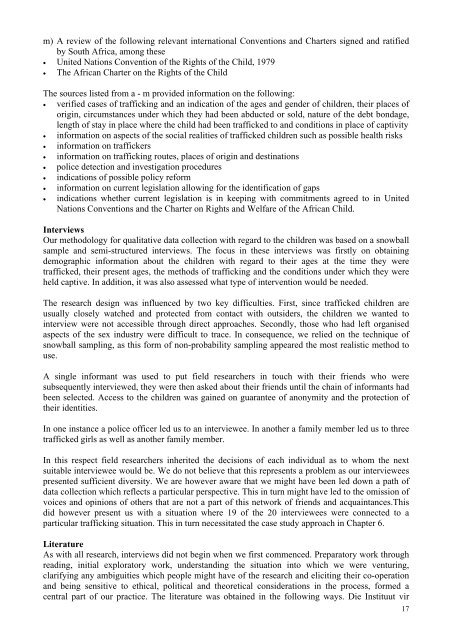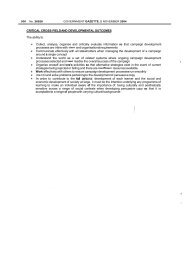The trafficking of children for purposes of sexual exploitation
The trafficking of children for purposes of sexual exploitation
The trafficking of children for purposes of sexual exploitation
You also want an ePaper? Increase the reach of your titles
YUMPU automatically turns print PDFs into web optimized ePapers that Google loves.
m) A review <strong>of</strong> the following relevant international Conventions and Charters signed and ratified<br />
by South Africa, among these<br />
• United Nations Convention <strong>of</strong> the Rights <strong>of</strong> the Child, 1979<br />
• <strong>The</strong> African Charter on the Rights <strong>of</strong> the Child<br />
<strong>The</strong> sources listed from a - m provided in<strong>for</strong>mation on the following:<br />
• verified cases <strong>of</strong> <strong>trafficking</strong> and an indication <strong>of</strong> the ages and gender <strong>of</strong> <strong>children</strong>, their places <strong>of</strong><br />
origin, circumstances under which they had been abducted or sold, nature <strong>of</strong> the debt bondage,<br />
length <strong>of</strong> stay in place where the child had been trafficked to and conditions in place <strong>of</strong> captivity<br />
• in<strong>for</strong>mation on aspects <strong>of</strong> the social realities <strong>of</strong> trafficked <strong>children</strong> such as possible health risks<br />
• in<strong>for</strong>mation on traffickers<br />
• in<strong>for</strong>mation on <strong>trafficking</strong> routes, places <strong>of</strong> origin and destinations<br />
• police detection and investigation procedures<br />
• indications <strong>of</strong> possible policy re<strong>for</strong>m<br />
• in<strong>for</strong>mation on current legislation allowing <strong>for</strong> the identification <strong>of</strong> gaps<br />
• indications whether current legislation is in keeping with commitments agreed to in United<br />
Nations Conventions and the Charter on Rights and Welfare <strong>of</strong> the African Child.<br />
Interviews<br />
Our methodology <strong>for</strong> qualitative data collection with regard to the <strong>children</strong> was based on a snowball<br />
sample and semi-structured interviews. <strong>The</strong> focus in these interviews was firstly on obtaining<br />
demographic in<strong>for</strong>mation about the <strong>children</strong> with regard to their ages at the time they were<br />
trafficked, their present ages, the methods <strong>of</strong> <strong>trafficking</strong> and the conditions under which they were<br />
held captive. In addition, it was also assessed what type <strong>of</strong> intervention would be needed.<br />
<strong>The</strong> research design was influenced by two key difficulties. First, since trafficked <strong>children</strong> are<br />
usually closely watched and protected from contact with outsiders, the <strong>children</strong> we wanted to<br />
interview were not accessible through direct approaches. Secondly, those who had left organised<br />
aspects <strong>of</strong> the sex industry were difficult to trace. In consequence, we relied on the technique <strong>of</strong><br />
snowball sampling, as this <strong>for</strong>m <strong>of</strong> non-probability sampling appeared the most realistic method to<br />
use.<br />
A single in<strong>for</strong>mant was used to put field researchers in touch with their friends who were<br />
subsequently interviewed, they were then asked about their friends until the chain <strong>of</strong> in<strong>for</strong>mants had<br />
been selected. Access to the <strong>children</strong> was gained on guarantee <strong>of</strong> anonymity and the protection <strong>of</strong><br />
their identities.<br />
In one instance a police <strong>of</strong>ficer led us to an interviewee. In another a family member led us to three<br />
trafficked girls as well as another family member.<br />
In this respect field researchers inherited the decisions <strong>of</strong> each individual as to whom the next<br />
suitable interviewee would be. We do not believe that this represents a problem as our interviewees<br />
presented sufficient diversity. We are however aware that we might have been led down a path <strong>of</strong><br />
data collection which reflects a particular perspective. This in turn might have led to the omission <strong>of</strong><br />
voices and opinions <strong>of</strong> others that are not a part <strong>of</strong> this network <strong>of</strong> friends and acquaintances.This<br />
did however present us with a situation where 19 <strong>of</strong> the 20 interviewees were connected to a<br />
particular <strong>trafficking</strong> situation. This in turn necessitated the case study approach in Chapter 6.<br />
Literature<br />
As with all research, interviews did not begin when we first commenced. Preparatory work through<br />
reading, initial exploratory work, understanding the situation into which we were venturing,<br />
clarifying any ambiguities which people might have <strong>of</strong> the research and eliciting their co-operation<br />
and being sensitive to ethical, political and theoretical considerations in the process, <strong>for</strong>med a<br />
central part <strong>of</strong> our practice. <strong>The</strong> literature was obtained in the following ways. Die Instituut vir<br />
17
















